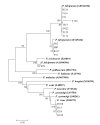Molecular epidemiology of Plasmodium species prevalent in Yemen based on 18 s rRNA
- PMID: 21092097
- PMCID: PMC2997089
- DOI: 10.1186/1756-3305-3-110
Molecular epidemiology of Plasmodium species prevalent in Yemen based on 18 s rRNA
Abstract
Background: Malaria is an endemic disease in Yemen and is responsible for 4.9 deaths per 100,000 population per year and 43,000 disability adjusted life years lost. Although malaria in Yemen is caused mainly by Plasmodium falciparum and Plasmodium vivax, there are no sequence data available on the two species. This study was conducted to investigate the distribution of the Plasmodium species based on the molecular detection and to study the molecular phylogeny of these parasites.
Methods: Blood samples from 511 febrile patients were collected and a partial region of the 18 s ribosomal RNA (18 s rRNA) gene was amplified using nested PCR. From the 86 positive blood samples, 13 Plasmodium falciparum and 4 Plasmodium vivax were selected and underwent cloning and, subsequently, sequencing and the sequences were subjected to phylogenetic analysis using the neighbor-joining and maximum parsimony methods.
Results: Malaria was detected by PCR in 86 samples (16.8%). The majority of the single infections were caused by P. falciparum (80.3%), followed by P. vivax (5.8%). Mixed infection rates of P. falciparum + P. vivax and P. falciparum + P. malariae were 11.6% and 2.3%, respectively. All P. falciparum isolates were grouped with the strain 3D7, while P. vivax isolates were grouped with the strain Salvador1. Phylogenetic trees based on 18 s rRNA placed the P. falciparum isolates into three sub-clusters and P. vivax into one cluster. Sequence alignment analysis showed 5-14.8% SNP in the partial sequences of the 18 s rRNA of P. falciparum.
Conclusions: Although P. falciparum is predominant, P. vivax, P. malariae and mixed infections are more prevalent than has been revealed by microscopy. This overlooked distribution should be considered by malaria control strategy makers. The genetic polymorphisms warrant further investigation.
Figures


Similar articles
-
[Species Identification and Sequence Analysis of Plasmodium spp. in Border Areas of Yunnan Province by 18S rRNA-based Nested PCR].Zhongguo Ji Sheng Chong Xue Yu Ji Sheng Chong Bing Za Zhi. 2016 Jun;34(3):220-6. Zhongguo Ji Sheng Chong Xue Yu Ji Sheng Chong Bing Za Zhi. 2016. PMID: 30129721 Chinese.
-
Detection of malaria with light microscopy and Nested polymerase chain reaction (Nested PCR) methods in peripheral blood expansions and investigation of the genetic diversity of Plasmodium species by 18S rRNA gene in Southeast of Iran.Microb Pathog. 2019 Dec;137:103782. doi: 10.1016/j.micpath.2019.103782. Epub 2019 Oct 7. Microb Pathog. 2019. PMID: 31600540
-
Comparative detection of Plasmodium vivax and Plasmodium falciparum DNA in saliva and urine samples from symptomatic malaria patients in a low endemic area.Malar J. 2010 Mar 9;9:72. doi: 10.1186/1475-2875-9-72. Malar J. 2010. PMID: 20214828 Free PMC article.
-
A large proportion of asymptomatic Plasmodium infections with low and sub-microscopic parasite densities in the low transmission setting of Temotu Province, Solomon Islands: challenges for malaria diagnostics in an elimination setting.Malar J. 2010 Sep 7;9:254. doi: 10.1186/1475-2875-9-254. Malar J. 2010. PMID: 20822506 Free PMC article.
-
Human malaria diagnosis using a single-step direct-PCR based on the Plasmodium cytochrome oxidase III gene.Malar J. 2016 Feb 29;15:128. doi: 10.1186/s12936-016-1185-x. Malar J. 2016. PMID: 26928594 Free PMC article.
Cited by
-
High frequency of Plasmodium falciparum chloroquine resistance marker (pfcrt T76 mutation) in Yemen: an urgent need to re-examine malaria drug policy.Parasit Vectors. 2011 May 27;4:94. doi: 10.1186/1756-3305-4-94. Parasit Vectors. 2011. PMID: 21619624 Free PMC article.
-
A retrospective analysis of the malaria trend in Yemen over the sixteen-years, from 2006 to 2021.BMC Public Health. 2025 Jan 20;25(1):239. doi: 10.1186/s12889-025-21466-4. BMC Public Health. 2025. PMID: 39833788 Free PMC article.
-
High heterogeneity of malaria transmission and a large sub-patent and diverse reservoir of infection in Wusab As Safil district, Republic of Yemen.Malar J. 2016 Apr 8;15:193. doi: 10.1186/s12936-016-1249-y. Malar J. 2016. PMID: 27059182 Free PMC article.
-
Epidemiology of malaria in endemic areas.Mediterr J Hematol Infect Dis. 2012;4(1):e2012060. doi: 10.4084/MJHID.2012.060. Epub 2012 Oct 4. Mediterr J Hematol Infect Dis. 2012. PMID: 23170189 Free PMC article.
-
Hematological Parameters in Severe Complicated Plasmodium falciparum Malaria among Adults in Aden.Turk J Haematol. 2013 Dec;30(4):394-9. doi: 10.4274/Tjh.2012.0086. Epub 2013 Dec 5. Turk J Haematol. 2013. PMID: 24385830 Free PMC article.
References
-
- WHO. World Malaria Report. World Health Organization; 2005.
LinkOut - more resources
Full Text Sources
Molecular Biology Databases

